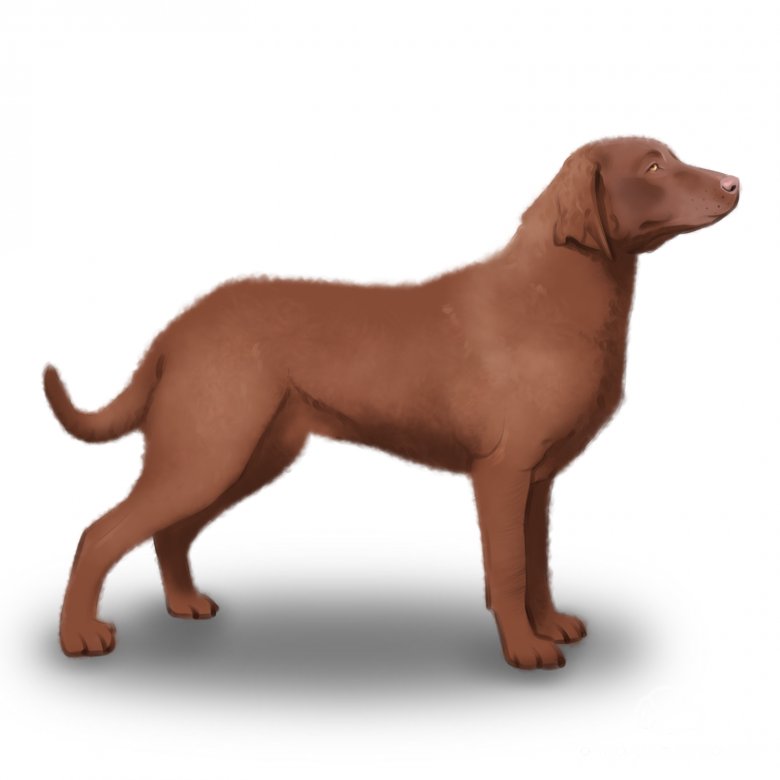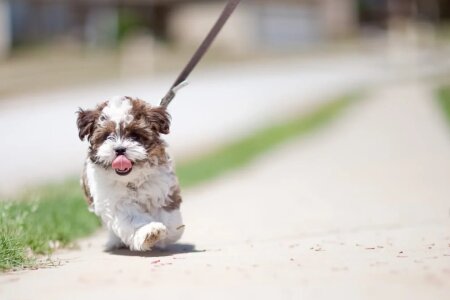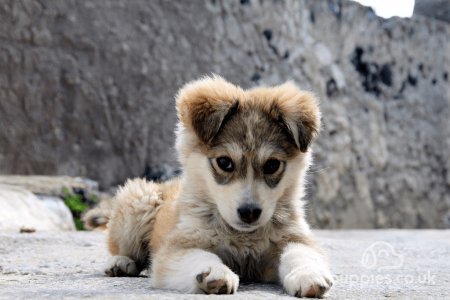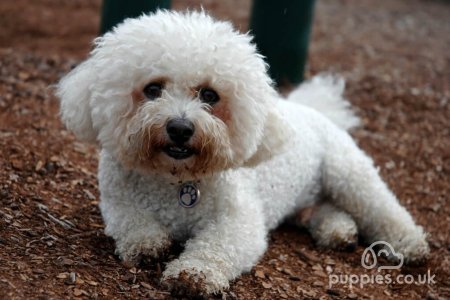Chesapeake Bay Retriever (Chessie)
Overview
The Chesapeake Bay Retriever is an intelligent, active and talented gundog. This retriever’s double coat is very distinctive, it is completely water-resistant, which makes them unique and stand out against other dog breeds. The Chessie is large and has lots of energy, making them great for active families. These retrievers are gentle around children and friendly to strangers. This is a sporting dog that loves water and interactive games.
Physical Appearance
The Chesapeake Bay Retriever is a well proportioned dog that is known for their distinctive double coat and webbed feet. The female and males are noticeably different with the males being larger. The Chesapeake also has a distinctive broad head that is slightly pointed with a medium stop. Chesapeakes have medium sized eyes that are amber or yellow in colour, they have small ears that are set high on the dog's head and their nostrils are well developed.
Chessies are powerful and well muscled, they have a broad, deep chest and straight, strong legs. These Retrievers have webbed feet that make them excellent swimmers. This breed also has a long tail that can be straight or slightly curved and is carried level. The distinctive coat of the Chessie has an oily outer coat and a wooly undercoat which makes them weather-resistant. The Chesapeake can be brown, dark brown, deadgrass, light brown, ash or sedge in colour.
How big do Chesapeake Bay Retrievers get?
Height - Males: 61 - 66cm, Females: 56 - 64cm
Weight - Males: 34 - 45kg, Females: 30 - 40kg
Character Traits
The Chesapeake is an affectionate dog that is loyal and protective. Chessies are independent thinkers which is a trait that can make them challenging to train, however in experienced hands these dogs are fast learners. The Chesapeake matures slowly so they remain playful and puppy-like for the first few years. This breed is high energy so they need to spend lots of time outside going for long walks and playing in a secure garden.
Are Chesapeake Bay Retrievers intelligent? Yes
Are Chesapeake Bay Retrievers affectionate? Yes
Do Chesapeake Bay Retrievers have high or low energy levels? High energy levels
Are Chesapeake Bay Retrievers loyal? Yes
Are Chesapeake Bay Retrievers playful? Yes
Are Chesapeake Bay Retrievers aggressive? No
Are Chesapeake Bay Retrievers easy to train? Yes, in experienced hands
Are Chesapeake Bay Retrievers good guard dogs? They are good watchdogs but not good guard dogs
Ability to Socialise
Chessies are friendly dogs that tend to get on well with other dogs. The breed is even-tempered and when they have been well socialised they are usually pretty laid back about meeting new dogs and people. If the Chesapeake has grown up with other pets they will be well behaved around them but a Chessie may still chase unfamiliar cats and other animals. The Chesapeake has a reputation for being great with children, they are friendly, calm and patient around kids.
Do Chesapeake Bay Retrievers get along with other pets? Yes, if they have grown up together
Do Chesapeake Bay Retrievers get along with other dogs? Yes
Are Chesapeake Bay Retrievers good with kids? Yes
Are Chesapeake Bay Retrievers good with strangers? Yes
Lifestyle Suitability
Chesapeakes are best suited to living in the countryside where they can spend lots of time outside. The Chessie isn’t a dog breed that can live in an apartment and they need to live with experienced owners who can handle and train the Chesapeake correctly. Without appropriate training, the Chesapeake can become dominant, which makes them difficult to handle. Chessies don’t like to be left on their own so they need a household where someone stays home with them.
Are Chesapeake Bay Retrievers good for first-time owners? No, they need experienced owners
Are Chesapeake Bay Retrievers hypoallergenic? No
Are Chesapeake Bay Retrievers prone to drooling? No
Are Chesapeake Bay Retrievers a good breed for apartment living? No
Do Chesapeake Bay Retrievers shed a lot? No, they shed moderately
Do Chesapeake Bay Retrievers bark a lot? No
Can Chesapeake Bay Retrievers be left alone at home? No
Can Chesapeake Bay Retrievers handle the heat? Yes
Can Chesapeake Bay Retrievers handle cold temperatures? Yes
Are Chesapeake Bay Retrievers sensitive to loud noises? No
General Health & Health Issues
The Chessie has an average life span of 10 - 12 years. This gundog is generally healthy but there are a number of conditions that are known to affect the Chesapeake Bay Retriever breed including:
Hip dysplasia - This is a painful condition caused by the abnormal development of the hip joints. Hip dysplasia can lead to arthritis. Treatment options include medication, physiotherapy, lifestyle changes and potentially surgery.
Eye problems - the Chesapeake is prone to a number of eye problems including cataracts, progressive retinal atrophy and entropion. The treatment will depend on the condition but may include medicine and surgery.
Epilepsy - This is a common cause of seizures in dogs. Treatment depends on the individual circumstances but can include anticonvulsants and hospitilisation. Sometimes epilepsy doesn’t require treatment but blood tests may be taken for diagnosis purposes.
Bloat - as the Chesapeake is a deep-chested breed they are more at risk of experiencing bloat. If you notice your dog is getting a swollen tummy, contact a vet immediately. This is considered a medical emergency.
Hypothyroidism - This is when the thyroid glands are underactive so don’t produce enough thyroid hormones. Treatment is usually medication that the dog will be on for the rest of their life. The medication will replace the missing thyroid hormones.
Heart disease - Treatment for heart issues can involve monitoring, medication or surgery. Symptoms of a heart problem include breathlessness, panting, lethargy, coughing, a heart murmur and collapse.
How long do Chesapeake Bay Retrievers live? 10 - 12 years
Exercise & Play Time
Chessies have a huge amount of energy and they need to be spending a lot of time outside each day. The Chesapeake breed needs at least 2 hours of exercise per day and they need access to a secure garden where they can roam around freely. When walking a Chesapeake Bay Retriever off lead it is important you only do so in a secure area where there is no livestock or wildlife around. To keep Chesapeakes busy and stimulated it is a good idea to enrol them in canine sports such as agility and obedience. As Chesapeakes are slow to mature it is important not to over exercise them when they are young.
How much exercise does a Chesapeake Bay Retriever need? At least 2 hours per day
Do Chesapeake Bay Retrievers like water play? Yes, they love water and will swim at any opportunity they get
Nutrition & Feeding
Chesapeakes have a healthy appetite and don’t have any breed-specific dietary requirements. They do well on a high-quality dry food and as this breed is prone to suffering from bloat it is necessary to feed them a few smaller portions rather than one big meal. Placing their food bowl on a stand can also help them eat comfortably.
As a rough guide, a Chesapeake puppy needs to eat between 270 - 570g of dry food per day, the actual amount is entirely dependent on the age and build of the puppy. As this is only a rough estimate and every dog is different, it is necessary to have a personal dietary plan made so you know exactly how much your dog needs based on their individual circumstances.
Are Chesapeake Bay Retrievers prone to weight gain? No
How much should I feed a Chesapeake Bay Retriever puppy? Between 270 - 570g of good quality dry food per day depending on the age and build of the puppy
How much should I feed an adult Chesapeake Bay Retriever? Between 350 - 500g of good quality dry food per day depending on the weight and activity level of the dog
Care & Maintenance
Grooming: The medium length coat of the Chesapeake has minimal grooming needs. The water resistant nature of the Chessies coat means all water and dirt just rolls off them. Brushing the Chessie a couple of times a week is good to keep them looking and feeling good. It’s also necessary to check and clean the Chessies teeth and ears on a regular basis and trim their nails as needed.
Emotional Care: The Chesapeake is an intelligent, active dog that needs plenty of exercise and mental stimulation each day. If a Chessie doesn’t get enough training and activity sessions each day they can become bored, unruly and hard to manage. If you want to keep your Chesapeake happy then take them to canine sports and let them swim in safe local spots.
History of the Chesapeake Bay Retriever
The Chesapeake Bay Retriever is believed to have originated from two puppies that were rescued from a shipwreck 200 years ago in Maryland. These puppies were thought to be Newfoundland type dogs and had a love for water. The dogs were bred with local retriever type dogs and the offspring is believed to be one of the dogs used to develop the Chesapeake Bay Retriever. It is thought that Irish Water Spaniels, Flat Coated Retrievers, Curly Coated Retrievers and Coonhounds were all used in the creation of the Chesapeake Bay Retriever we see today.
The chessie was first seen in the UK in 1933 and was a popular gundog in the country by the 1970s. Today, Chesapeakes are still a popular choice as a working dog and as a family pet.
Interesting Facts About Chesapeake Bay Retrievers
Chesapeake Bay Retrievers have webbed feet
The mascot of Maryland University is the Chesapeake Bay Retriever
Theodore Roosevelt owned a Chesapeake Bay Retriever
The Chessie has a distinctive water-resistant coat
Getting a Chesapeake Bay Retriever Puppy
If you’re ready to bring a dog into your family, read our buying guide for advice on buying a new puppy. When looking for your new puppy, be aware of scams and bad practices. At Puppies, all breeders are vetted to ensure they are responsible. Take a look at our Chesapeake Bay Retriever puppy page to find available dogs in your area.
How much does a Chesapeake Bay Retriever cost to buy? £800 - £2000
How much does a Chesapeake Bay Retriever cost to feed? £55 per month
How much does insurance for a Chesapeake Bay Retriever cost? £35 per month
An alternative option is to adopt a Chessie. Speak to your local dog rescue centre or contact the associations below about adoption:
Speak to the Chesapeake Bay Retriever Club about rehoming
Adopt a Chesapeake Bay Retriever with the Dogs Trust











